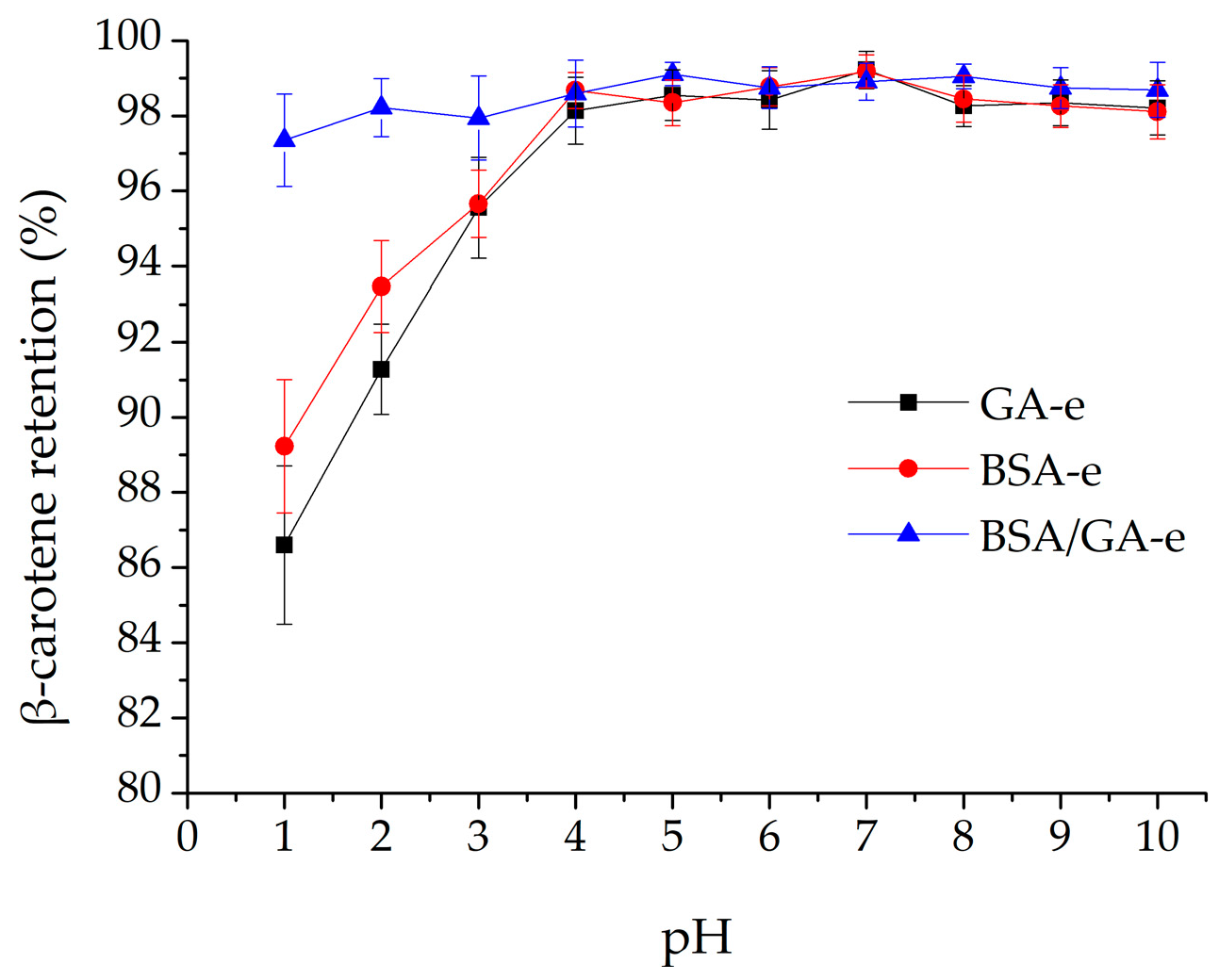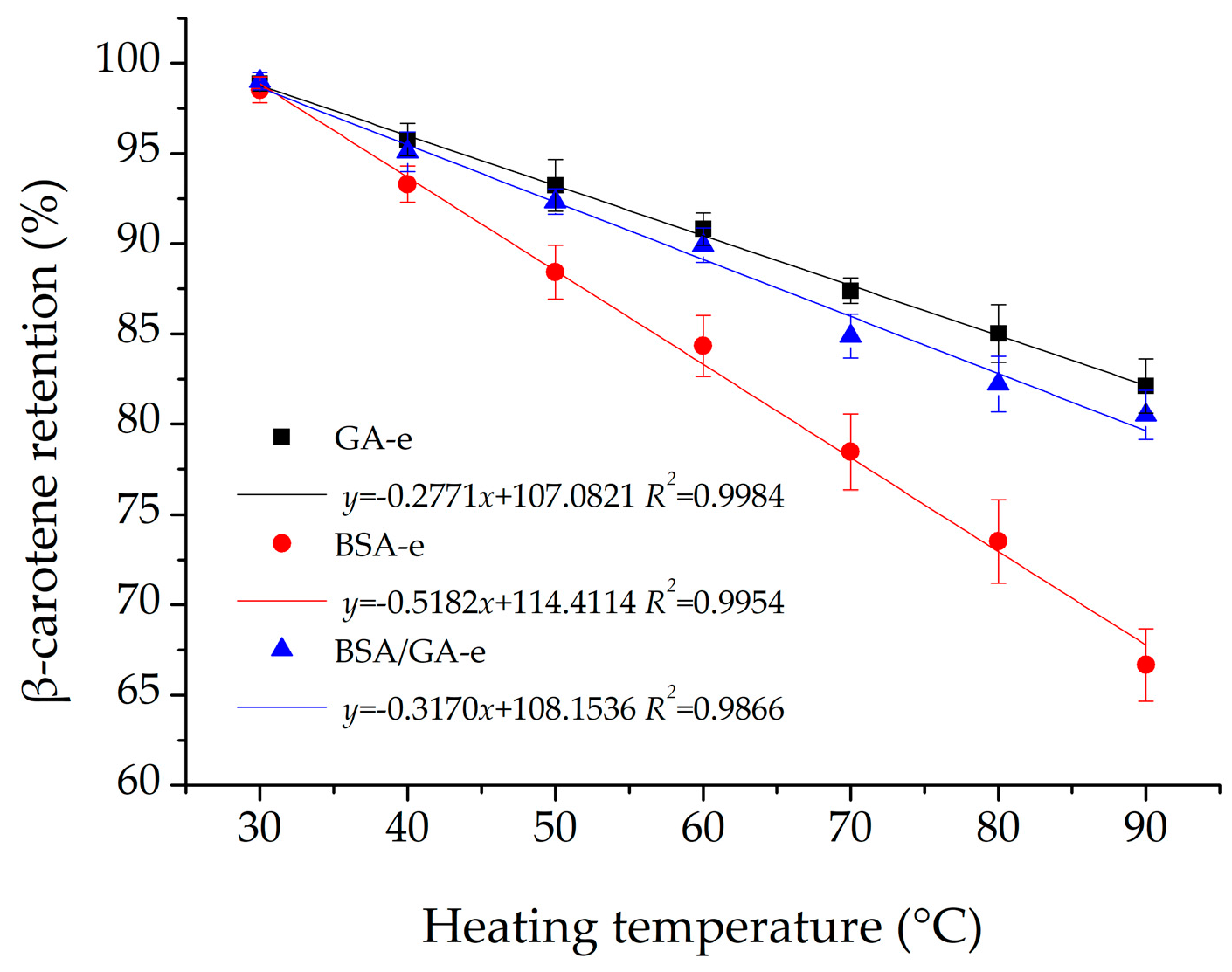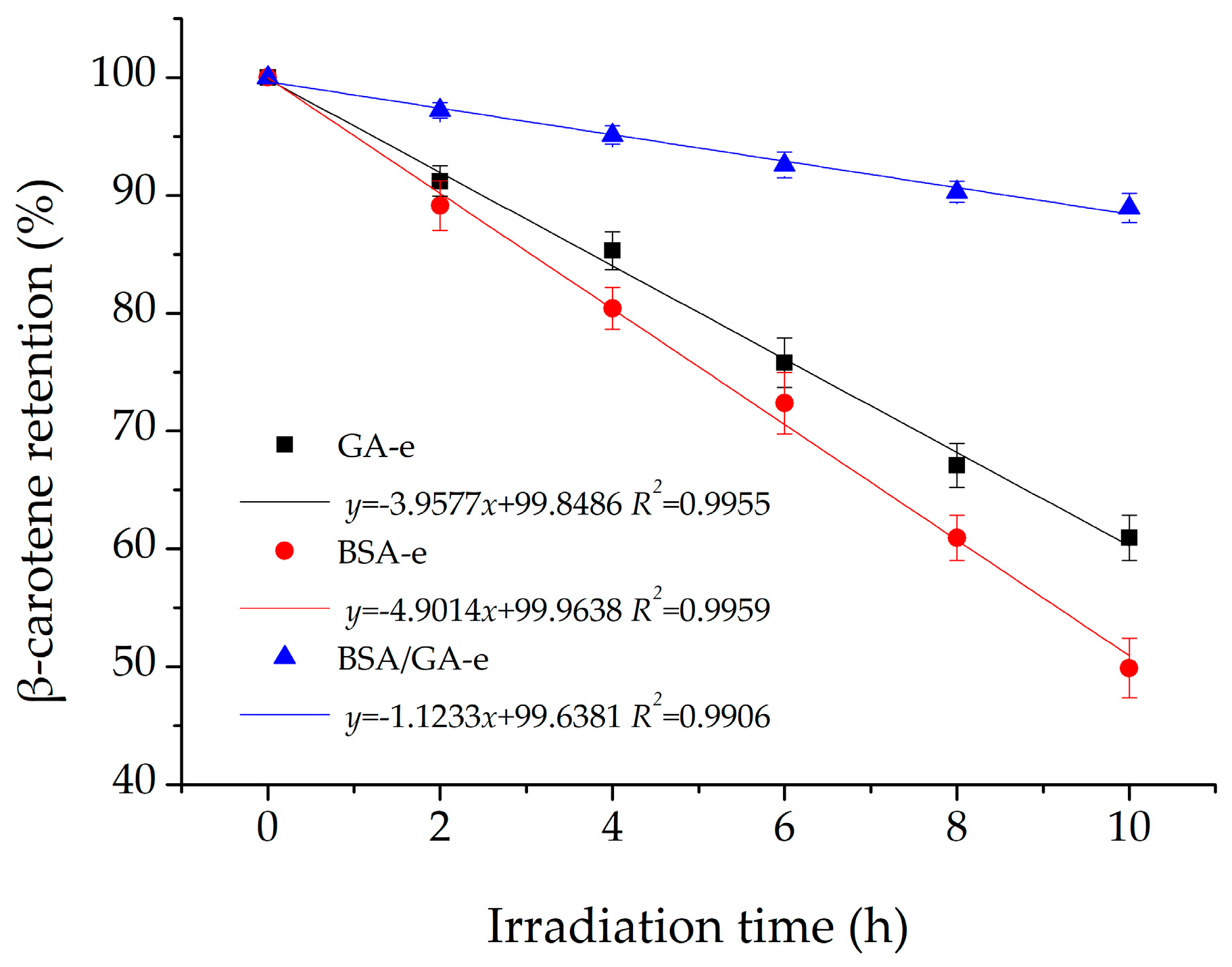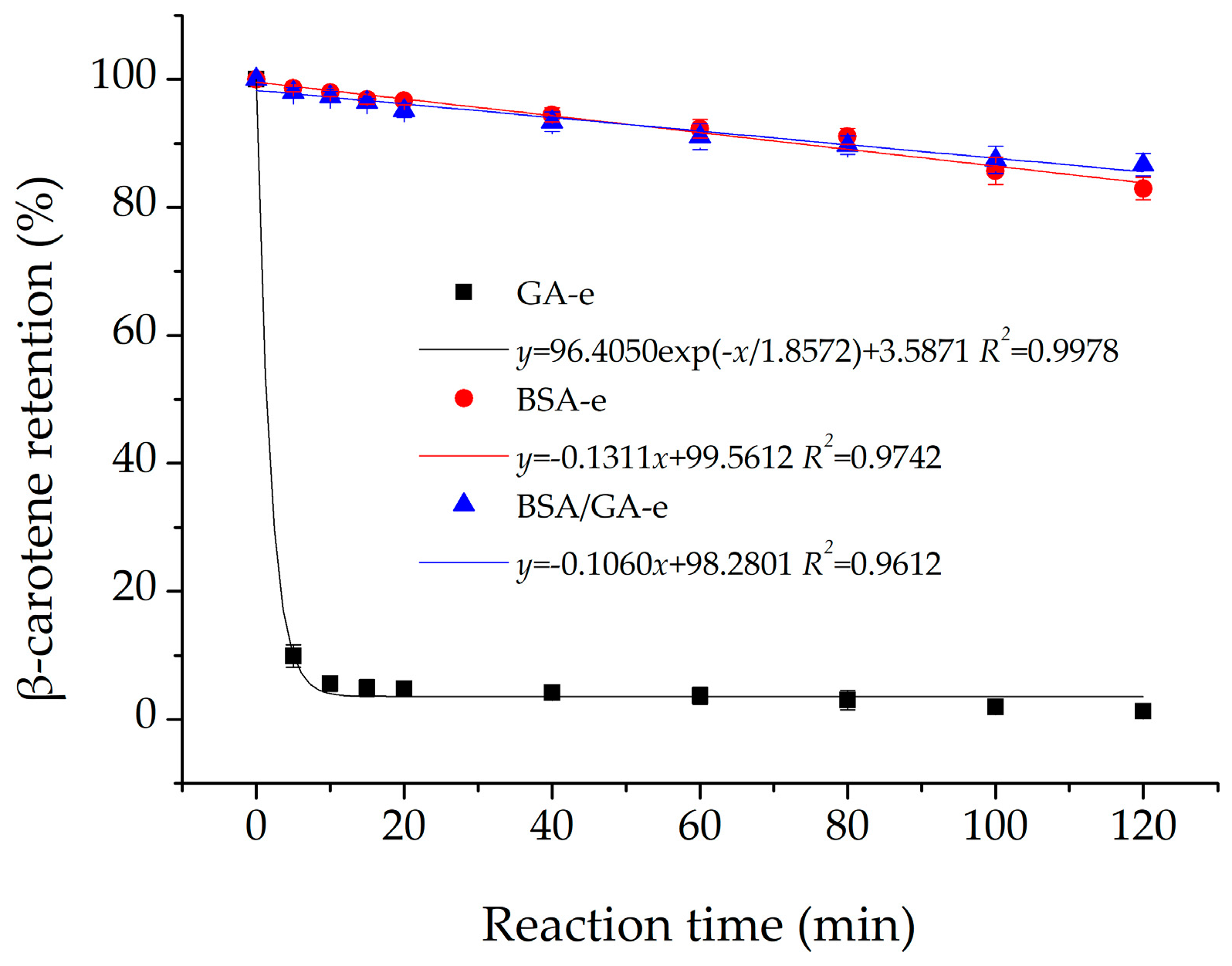Physicochemical Properties and Chemical Stability of β-Carotene Bilayer Emulsion Coated with Bovine Serum Albumin and Arabic Gum Compared to Monolayer Emulsions
Abstract
:1. Introduction
2. Results and Discussion
2.1. Physicochemical Properties of the Monolayer and Bilayer Emulsions
2.2. Rheological Behavior of the Monolayer and Bilayer Emulsions
2.3. Evaluation of the Chemical Stability of the Monolayer and Bilayer Emulsions
2.3.1. pH
2.3.2. Thermal Treatment
2.3.3. UV Radiation
2.3.4. Strong Oxidant
2.3.5. Storage Time
3. Materials and Methods
3.1. Materials
3.2. Preparation of β-Carotene Emulsions
3.2.1. Preparation of Aqueous and Oil Phase
3.2.2. Monolayer Emulsion Preparation
3.2.3. Bilayer Emulsion Preparation
3.3. Measurements of Droplet Size and Size Distribution
3.4. Measurements of Zeta Potential
3.5. Measurement of Interfacial Tension of Emulsions
3.6. Measurement of Rheological Behavior of Emulsions
3.7. Evaluation of the Chemical Stability of Emulsions
3.7.1. pH
3.7.2. Thermal Treatment
3.7.3. UV Radiation
3.7.4. Strong Oxidant
3.7.5. Storage Time
3.8. Analysis of β-Carotene Content
3.9. Statistical Analysis
4. Conclusions
Acknowledgments
Author Contributions
Conflicts of Interest
References
- Durante, M.; Lenucci, M.S.; D’Amico, L.; Piro, G.; Mita, G. Effect of drying and co-matrix addition on the yield and quality of supercritical CO₂ extracted pumpkin (Cucurbita moschata Duch.) oil. Food Chem. 2014, 148, 314–320. [Google Scholar] [CrossRef] [PubMed]
- Álvarez, R.; Vaz, B.; Gronemeyer, H.; de Lera, Á.R. Functions, therapeutic applications, and synthesis of retinoids and carotenoids. Chem. Rev. 2014, 114, 1–125. [Google Scholar] [CrossRef] [PubMed]
- Haskell, M.J. The challenge to reach nutritional adequacy for vitamin A: β-carotene bioavailability and conversion—Evidence in humans. Am. J. Clin. Nutr. 2012, 96, 1193S–1203S. [Google Scholar] [CrossRef] [PubMed]
- Donhowe, E.G.; Kong, F. Beta-carotene: Digestion, Microencapsulation, and In Vitro Bioavailability. Food Bioprocess Technol. 2014, 7, 338–354. [Google Scholar] [CrossRef]
- Holden, B.A.; Fricke, T.R.; Wilson, D.A.; Jong, M.; Naidoo, K.S.; Sankaridurg, P.; Wong, T.Y.; Naduvilath, T.J.; Resnikoff, S. Global Prevalence of Myopia and High Myopia and Temporal Trends from 2000 through 2050. Ophthalmology 2016, 123, 1036–1042. [Google Scholar] [CrossRef] [PubMed]
- Strobel, M.; Tinz, J.; Biesalski, H.K. The importance of β-carotene as a source of vitamin A with special regard to pregnant and breastfeeding women. Eur. J. Nutr. 2007, 46 (Suppl. 1), I1–20. [Google Scholar] [CrossRef] [PubMed]
- Roura, S.M.D.; Piedra, J.; Miravet, S.; de Herreros, A.G.; Dunach, M. Beta-carotene reduces oxidative stress, improves glutathione metabolism and modifies antioxidant defense systems in lead-exposed workers. Toxicol. Appl. Pharmacol. 2014, 280, 36–41. [Google Scholar]
- Sluijs, I.; Cadier, E.; Beulens, J.W.; van der, A.D.L.; Spijkerman, A.M.; van der Schouw, Y.T. Dietary intake of carotenoids and risk of type 2 diabetes. Nutr. Metab. Cardiovasc. Dis. 2015, 25, 376–381. [Google Scholar] [CrossRef] [PubMed]
- Tanaka, T.; Shnimizu, M.; Moriwaki, H. Cancer chemoprevention by carotenoids. Molecules 2012, 17, 3202–3242. [Google Scholar] [CrossRef] [PubMed]
- Boon, C.S.; McClements, D.J.; Weiss, J.; Decker, E.A. Factors influencing the chemical stability of carotenoids in foods. Crit. Rev. Food Sci. Nutr. 2010, 50, 515–532. [Google Scholar] [CrossRef] [PubMed]
- Liu, J.; Shi, W.Q.; Cao, Y.; He, L.P.; Guan, K.; Ling, W.H.; Chen, Y.M. Higher serum carotenoid concentrations associated with a lower prevalence of the metabolic syndrome in middle-aged and elderly Chinese adults. Br. J. Nutr. 2014, 112, 2041–2048. [Google Scholar] [CrossRef] [PubMed]
- Chen, J.J.; Li, F.; Li, Z.Z.; McClements, D.J.; Xiao, H. Encapsulation of carotenoids in emulsion-based delivery systems: Enhancement of β-carotene water-dispersibility and chemical stability. Food Hydrocoll. 2017, 69, 49–55. [Google Scholar] [CrossRef]
- Chen, H.Q.; Zhong, Q.X. Thermal and UV stability of β-carotene dissolved in peppermint oil microemulsified by sunflower lecithin and Tween 20 blend. Food Chem. 2015, 174, 630–636. [Google Scholar] [CrossRef] [PubMed]
- McClements, D.J.; Zou, L.Q.; Zhang, R.J.; Salvia-Trujillo, L.; Kumosani, T.; Xiao, H. Enhancing Nutraceutical Performance Using Excipient Foods: Designing Food Structures and Compositions to Increase Bioavailability. Compr. Rev. Food Sci. Food Saf. 2015, 14, 824–847. [Google Scholar] [CrossRef]
- Salvia-Trujillo, L.; Qian, C.; Martín-Belloso, O.; McClements, D.J. Modulating β-carotene bioaccessibility by controlling oil composition and concentration in edible nanoemulsions. Food Chem. 2013, 139, 878–884. [Google Scholar] [CrossRef] [PubMed]
- Soukoulis, C.; Bohn, T. A comprehensive overview on the micro- and nano-technological encapsulation advances for enhancing the chemical stability and bioavailability of carotenoids. Crit. Rev. Food Sci. Nutr. 2018, 58, 1–36. [Google Scholar] [CrossRef] [PubMed]
- Qian, C.; Decker, E.A.; Xiao, H.; McClements, D.J. Nanoemulsion delivery systems: Influence of carrier oil on β-carotene bioaccessibility. Food Chem. 2012, 135, 1440–1447. [Google Scholar] [CrossRef] [PubMed]
- Dickinson, E. Interfacial structure and stability of food emulsions as affected by protein-polysaccharide interactions. Soft Matter 2008, 4, 932–942. [Google Scholar] [CrossRef]
- Qian, C.; Decker, E.A.; Xiao, H.; McClements, D.J. Physical and chemical stability of β-carotene-enriched nanoemulsions: Influence of pH, ionic strength, temperature, and emulsifier type. Food Chem. 2012, 132, 1221–1229. [Google Scholar] [CrossRef] [PubMed]
- Burgos-Díaz, C.; Wandersleben, T.; Marqués, A.M.; Rubilar, M. Multilayer emulsions stabilized by vegetable proteins and polysaccharides. Curr. Opin. Colloid Interface Sci. 2016, 25, 51–57. [Google Scholar] [CrossRef]
- Guzey, D.; McClements, D.J. Formation, stability and properties of multilayer emulsions for application in the food industry. Adv. Colloid Interface Sci. 2006, 128–130, 227–248. [Google Scholar] [CrossRef] [PubMed]
- McClements, D.J. Advances in fabrication of emulsions with enhanced functionality using structural design principles. Curr. Opin. Colloid Interface Sci. 2012, 17, 235–245. [Google Scholar] [CrossRef]
- Bortnowska, G. Multilayer oil-in-water emulsions: Formation, characteristics and application as the carriers for lipophilic bioactive food components—A review. Pol. J. Food Nutr. Sci. 2015, 65, 157–166. [Google Scholar] [CrossRef]
- McClements, D.J. Design of Nano-Laminated Coatings to Control Bioavailability of Lipophilic Food Components. J. Food Sci. 2010, 75, R30–R42. [Google Scholar] [CrossRef] [PubMed]
- Aoki, T.; Decker, E.A.; McClements, D.J. Influence of environmental stresses on stability of O/W emulsions containing droplets stabilized by multilayered membranes produced by a layer-by-layer electrostatic deposition technique. Food Hydrocoll. 2005, 19, 209–220. [Google Scholar] [CrossRef]
- Guzey, D.; Kim, H.J.; McClements, D.J. Factors influencing the production of o/w emulsions stabilized by β-lactoglobulin–pectin membranes. Food Hydrocoll. 2004, 18, 967–975. [Google Scholar] [CrossRef]
- Moreau, L.; Kim, H.J.; Decker, E.A.; McClements, D.J. Production and characterization of oil-in-water emulsions containing droplets stabilized by beta-lactoglobulin-pectin membranes. J. Agric. Food Chem. 2003, 51, 6612–6617. [Google Scholar] [CrossRef] [PubMed]
- Güzey, D.; McClements, D.J. Influence of Environmental Stresses on O/W Emulsions Stabilized by β-Lactoglobulin–Pectin and β-Lactoglobulin–Pectin–Chitosan Membranes Produced by the Electrostatic Layer-by-Layer Deposition Technique. Food Biophys. 2006, 1, 30–40. [Google Scholar] [CrossRef]
- Liu, L.Y.; Zhao, Q.Z.; Liu, T.X.; Kong, J.; Long, Z.; Zhao, M.M. Sodium caseinate/carboxymethylcellulose interactions at oil–water interface: Relationship to emulsion stability. Food Chem. 2012, 132, 1822–1829. [Google Scholar] [CrossRef]
- Moschakis, T.; Murray, B.S.; Dickinson, E. Microstructural evolution of viscoelastic emulsions stabilised by sodium caseinate and xanthan gum. J. Colloid Interface Sci. 2005, 284, 714–728. [Google Scholar] [CrossRef] [PubMed]
- Wei, Z.H.; Gao, Y.X. Physicochemical properties of β-carotene bilayer emulsions coated by milk proteins and chitosan–EGCG conjugates. Food Hydrocoll. 2016, 52, 590–599. [Google Scholar] [CrossRef]
- Wang, S.S.; Chen, X.D.; Shi, M.X.; Zhao, L.H.; Li, W.; Chen, Y.Y.; Lu, M.L.; Wu, J.D.; Yuan, Q.P.; Li, Y. Absorption of whey protein isolated (WPI)-stabilized β-Carotene emulsions by oppositely charged oxidized starch microgels. Food Res. Int. 2015, 67, 315–322. [Google Scholar] [CrossRef]
- Xu, D.X.; Wang, X.Y.; Yuan, F.; Hou, Z.Q.; Gao, Y.X. Stability of β-Carotene in Oil-in-Water Emulsions Prepared by Mixed Layer and Bilayer of Whey Protein Isolate and Beet Pectin. J. Dispers. Sci. Technol. 2013, 34, 785–792. [Google Scholar] [CrossRef]
- Xu, D.X.; Yuan, F.; Gao, Y.X.; McClements, D.J.; Decker, E.A. Influence of pH, metal chelator, free radical scavenger and interfacial characteristics on the oxidative stability of β-carotene in conjugated whey protein–pectin stabilised emulsion. Food Chem. 2013, 139, 1098–1104. [Google Scholar] [CrossRef] [PubMed]
- Hou, Z.Q.; Gao, Y.X.; Fang, Y.; Liu, Y.W.; Li, C.L.; Xu, D.X. Investigation into the physicochemical stability and rheological properties of β-carotene emulsion stabilized by soybean soluble polysaccharides and chitosan. J. Agric. Food Chem. 2010, 58, 8604–8611. [Google Scholar] [CrossRef] [PubMed]
- Hou, Z.Q.; Zhang, M.; Liu, B.; Yan, Q.L.; Yuan, F.; Xu, D.X.; Gao, Y.X. Effect of chitosan molecular weight on the stability and rheological properties of β-carotene emulsions stabilized by soybean soluble polysaccharides. Food Hydrocoll. 2012, 26, 205–211. [Google Scholar] [CrossRef]
- McClements, D.J.; Bai, L.; Chung, C. Recent Advances in the Utilization of Natural Emulsifiers to Form and Stabilize Emulsions. Annu. Rev. Food Sci. Technol. 2017, 8, 205–236. [Google Scholar] [CrossRef] [PubMed]
- Singh, H. Aspects of milk-protein-stabilized emulsions. Food Hydrocoll. 2011, 25, 1938–1944. [Google Scholar] [CrossRef]
- Zhao, D.; Le, T.T.; Larsen, L.B.; Li, L.; Qin, D.; Su, G.Y.; Li, B. Effect of glycation derived from α-dicarbonyl compounds on the in vitro digestibility of β-casein and β-lactoglobulin: A model study with glyoxal, methylglyoxal and butanedione. Food Res. Int. 2017, 102, 313–322. [Google Scholar] [CrossRef] [PubMed]
- Wu, S.Y.; Pérez, M.D.; Puyol, P.; Sawyer, L. β-Lactoglobulin Binds Palmitate within Its Central Cavity. J. Biol. Chem. 1999, 274, 170–174. [Google Scholar] [CrossRef] [PubMed]
- Klinkesorn, U. The role of chitosan in emulsion formation and stabilization. Food Rev. Int. 2013, 29, 371–393. [Google Scholar] [CrossRef]
- Kim, D.Y.; Shin, W.S.; Hong, W.S. The unique behaviors of biopolymers, BSA and fucoidan, in a model emulsion system under different pH circumstances. Macromol. Res. 2010, 18, 1103–1108. [Google Scholar] [CrossRef]
- Dickinson, E. Mixed biopolymers at interfaces: Competitive adsorption and multilayer structures. Food Hydrocoll. 2011, 25, 1966–1983. [Google Scholar] [CrossRef]
- Piorkowski, D.T.; McClements, D.J. Beverage emulsions: Recent developments in formulation, production, and applications. Food Hydrocoll. 2014, 42, 5–41. [Google Scholar] [CrossRef]
- Damodaran, S. Protein Stabilization of Emulsions and Foams. J. Food Sci. 2010, 70, R54–R66. [Google Scholar] [CrossRef]
- McClements, D.J.; Rao, J. Food-grade nanoemulsions: Formulation, fabrication, properties, performance, biological fate, and potential toxicity. Crit. Rev. Food Sci. Nutr. 2011, 51, 285–330. [Google Scholar] [CrossRef] [PubMed]
- Zhao, J.J.; Wei, T.; Wei, Z.H.; Yuan, F.; Gao, Y.X. Influence of soybean soluble polysaccharides and beet pectin on the physicochemical properties of lactoferrin-coated orange oil emulsion. Food Hydrocoll. 2015, 44, 443–452. [Google Scholar] [CrossRef]
- Bai, L.; Huan, S.Q.; Li, Z.G.; McClements, D.J. Comparison of emulsifying properties of food-grade polysaccharides in oil-in-water emulsions: Gum arabic, beet pectin, and corn fiber gum. Food Hydrocoll. 2017, 66, 144–153. [Google Scholar] [CrossRef]
- Bouyer, E.; Mekhloufi, G.; Potier, I.L.; Kerdaniel, T.D.F.D.; Grossiord, J.L.; Rosilio, V.; Agnely, F. Stabilization mechanism of oil-in-water emulsions by β-lactoglobulin and gum arabic. J. Colloid Interface Sci. 2011, 354, 467–477. [Google Scholar] [CrossRef] [PubMed]
- Kim, H.; Kim, K.H.; Lee, H.R.; Jo, H.C.; Jeong, D.W.; Ryu, J.; Gweon, D.G.; Choi, S.Q. Formation of stable adhesive water-in-oil emulsions using a phospholipid and cosurfactants. J. Ind. Eng. Chem. 2017, 55, 198–203. [Google Scholar] [CrossRef]
- Pal, R. Rheology of simple and multiple emulsions. Curr. Opin. Colloid Interface Sci. 2011, 16, 41–60. [Google Scholar] [CrossRef]
- Mao, Y.Y.; McClements, D.J. Modification of emulsion properties by heteroaggregation of oppositely charged starch-coated and protein-coated fat droplets. Food Hydrocoll. 2013, 33, 320–326. [Google Scholar] [CrossRef]
- Taherian, A.R.; Fustier, P.; Ramaswamy, H.S. Effect of added oil and modified starch on rheological properties, droplet size distribution, opacity and stability of beverage cloud emulsions. J. Food Eng. 2006, 77, 687–696. [Google Scholar] [CrossRef]
- Dickinson, E.; Golding, M. Rheology of Sodium Caseinate Stabilized Oil-in-Water Emulsions. J. Colloid Interface Sci. 1997, 191, 166–176. [Google Scholar] [CrossRef] [PubMed]
- Taherian, A.R.; Fustier, P.; Britten, M.; Ramaswamy, H.S. Rheology and stability of beverage emulsions in the presence and absence of weighting agents: A review. Food Biophys. 2008, 3, 279–286. [Google Scholar] [CrossRef]
- Li, D.; Zhai, J.L.; Xu, M.; Jones, N.C.; Hoffmann, S.V.; Wooster, T.J. Conformational changes of globular proteins adsorbed at oil-in-water emulsion interfaces examined by Synchrotron Radiation Circular Dichroism. Food Hydrocoll. 2014, 34, 78–87. [Google Scholar]
- Relkin, P. Thermal unfolding of beta-lactoglobulin, alpha-lactalbumin, and bovine serum albumin. A thermodynamic approach. Crit. Rev. Food Sci. Nutr. 1996, 36, 565–601. [Google Scholar] [CrossRef] [PubMed]
- Jin, Q.W.; Li, X.B.; Cai, Z.X.; Zhang, F.; Yadav, M.P.; Zhang, H.B. A comparison of corn fiber gum, hydrophobically modified starch, gum arabic and soybean soluble polysaccharide: Interfacial dynamics, viscoelastic response at oil/water interfaces and emulsion stabilization mechanisms. Food Hydrocoll. 2017, 70, 329–344. [Google Scholar] [CrossRef]
- Liu, F.G.; Wang, D.; Sun, C.X.; McClements, D.J.; Gao, Y.X. Utilization of interfacial engineering to improve physicochemical stability of β-carotene emulsions: Multilayer coatings formed using protein and protein-polyphenol conjugates. Food Chem. 2016, 205, 129–139. [Google Scholar] [CrossRef] [PubMed]
- McClements, D.J.; Decker, E. Lipid Oxidation in Oil-in-Water Emulsions: Impact of Molecular Environment on Chemical Reactions in Heterogeneous Food Systems. J. Food Sci. 2000, 65, 1270–1282. [Google Scholar] [CrossRef]
- Zeeb, B.; Gibis, M.; Fischer, L.; Weiss, J. Crosslinking of interfacial layers in multilayered oil-in-water emulsions using laccase: Characterization and pH-stability. Food Hydrocoll. 2012, 27, 126–136. [Google Scholar] [CrossRef]
- Zeeb, B.; Gibis, M.; Fischer, L.; Weiss, J. Influence of interfacial properties on Ostwald ripening in crosslinked multilayered oil-in-water emulsions. J. Colloid Interface Sci. 2012, 387, 65–73. [Google Scholar] [CrossRef] [PubMed]
- Schmidt, J.M.; Damgaard, H.; Greve-Poulsen, M.; Larsen, L.B.; Hammershøj, M. Foam and emulsion properties of potato protein isolate and purified fractions. Food Hydrocoll. 2018, 74, 367–378. [Google Scholar] [CrossRef]
- Yuan, Y.; Gao, Y.X.; Zhao, J.; Mao, L.K. Characterization and stability evaluation of β-carotene nanoemulsions prepared by high pressure homogenization under various emulsifying conditions. Food Res. Int. 2008, 41, 61–68. [Google Scholar] [CrossRef]
Sample Availability: Samples of the compounds are available from the authors. |






| Emulsion Types | Z-Average Diameter (nm) | PDI | Zeta Potential (mV) | β-Carotene Encapsulation Ratio (%) | Interfacial Tension (mN/m) |
|---|---|---|---|---|---|
| GA-e | 774 ± 22 a | 0.43 ± 0.03 a | −31.93 ± 0.67 b | 90.1 ± 1.2 b | 50.45 ± 0.21 a |
| BSA-e | 199 ± 6 c | 0.21 ± 0.01 b | 41.47 ± 0.71 a | 95.1 ± 1.5 a | 41.12 ± 0.77 b |
| BSA/GA-e | 221 ± 5 b | 0.23 ± 0.02 b | −30.57 ± 0.71 b | 94.4 ± 0.7 a | 40.81 ± 0.86 b |
| Emulsion Types | σ0 (10−3 Pa) | κ (10−3 Pa·sn) | n | R2 |
|---|---|---|---|---|
| GA-e | 7.60 ± 0.41 a | 2.70 ± 0.11 b | 0.96 ± 0.01 a | 0.9995 |
| BSA-e | 2.73 ± 0.20 c | 2.19 ± 0.06 c | 0.92 ± 0.01 c | 0.9992 |
| BSA/GA-e | 5.31 ± 0.20 b | 3.31 ± 0.08 a | 0.93 ± 0.01 b | 0.9998 |
© 2018 by the authors. Licensee MDPI, Basel, Switzerland. This article is an open access article distributed under the terms and conditions of the Creative Commons Attribution (CC BY) license (http://creativecommons.org/licenses/by/4.0/).
Share and Cite
Sheng, B.; Li, L.; Zhang, X.; Jiao, W.; Zhao, D.; Wang, X.; Wan, L.; Li, B.; Rong, H. Physicochemical Properties and Chemical Stability of β-Carotene Bilayer Emulsion Coated with Bovine Serum Albumin and Arabic Gum Compared to Monolayer Emulsions. Molecules 2018, 23, 495. https://doi.org/10.3390/molecules23020495
Sheng B, Li L, Zhang X, Jiao W, Zhao D, Wang X, Wan L, Li B, Rong H. Physicochemical Properties and Chemical Stability of β-Carotene Bilayer Emulsion Coated with Bovine Serum Albumin and Arabic Gum Compared to Monolayer Emulsions. Molecules. 2018; 23(2):495. https://doi.org/10.3390/molecules23020495
Chicago/Turabian StyleSheng, Bulei, Lin Li, Xia Zhang, Wenjuan Jiao, Di Zhao, Xue Wang, Liting Wan, Bing Li, and Hui Rong. 2018. "Physicochemical Properties and Chemical Stability of β-Carotene Bilayer Emulsion Coated with Bovine Serum Albumin and Arabic Gum Compared to Monolayer Emulsions" Molecules 23, no. 2: 495. https://doi.org/10.3390/molecules23020495




